Related Research Articles

The Piano Concerto in A minor, Op. 16, composed by Edvard Grieg in 1868, was the only concerto Grieg completed. It is one of his most popular works, and is among the most popular of the genre. Grieg, being only 24 years old at the time of the composition, had taken inspiration from Robert Schumann's only concerto, also being in A minor.

The Piano Concerto No. 5 in E-flat major, Op. 73, known as the Emperor Concerto in English-speaking countries, is a concerto composed by Ludwig van Beethoven for piano and orchestra. Beethoven composed the concerto in 1809 under salary in Vienna, and he dedicated it to Archduke Rudolf, who was his patron, friend, and pupil. Its public premiere was on 28 November 1811 in Leipzig, with Friedrich Schneider as the soloist and Johann Philipp Christian Schulz conducting the Gewandhaus Orchestra. Beethoven, usually the soloist, could not perform due to declining hearing.
The Cello Concerto in A minor, Op. 129, by Robert Schumann was completed in a period of only two weeks, between 10 October and 24 October 1850, shortly after Schumann became the music director at Düsseldorf.
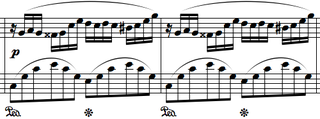
Frédéric Chopin's Fantaisie-Impromptu in C♯ minor, Op. posth. 66, WN 46 is a solo piano composition. It was composed in 1834 and published posthumously in 1855 despite Chopin's instruction that none of his unpublished manuscripts be published. The Fantaisie-Impromptu is one of Chopin's most frequently performed and popular compositions.
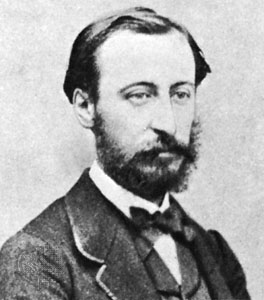
The Piano Concerto No. 2 in G minor, Op. 22 by Camille Saint-Saëns was composed in 1868 and is probably Saint-Saëns' most popular piano concerto. It was dedicated to Madame A. de Villers. At the première on 13 May the composer was the soloist and Anton Rubinstein conducted the orchestra. Saint-Saëns wrote the concerto in three weeks and had very little time to prepare for the première; consequently, the piece was not initially successful. The capricious changes in style provoked Zygmunt Stojowski to quip that it "begins with Bach and ends with Offenbach."

The Piano Sonata No. 18 in E♭ major, Op. 31, No. 3, is an 1802 sonata for solo piano by Ludwig van Beethoven. A third party gave the piece the nickname "The Hunt" due to one of its themes' resemblance to a horn call. Beethoven maintains a playful jocularity throughout much of the piece, but as in many of his early works, the jocular style can be heard as a facade, concealing profound ideas and depths of emotion.

The Piano Sonata No. 31 in A♭ major, Op. 110, by Ludwig van Beethoven was composed in 1821 and published in 1822. It is the middle piano sonata in the group of three that he wrote between 1820 and 1822, and is the penultimate of his piano sonatas. Though the sonata was commissioned in 1820, Beethoven did not begin work on Op. 110 until the latter half of 1821, and final revisions were completed in early 1822. The delay was due to factors such as Beethoven's work on the Missa solemnis and his deteriorating health. The original edition was published by Schlesinger in Paris and Berlin in 1822 without dedication, and an English edition was published by Muzio Clementi in 1823.

Leonard Bernstein's Symphony No. 2 The Age of Anxiety is a piece for orchestra and solo piano. The piece was composed from 1948 to 1949 in the United States and Israel, and was revised in 1965. It is titled after W. H. Auden's eponymous poem, and dedicated to Serge Koussevitzky.
The Concerto in C minor for Piano, Trumpet, and String Orchestra, Op. 35, was completed by Dmitri Shostakovich in 1933.
Caucasian Sketches, Suite No. 1, Op. 10 is an orchestral suite composed in 1894 and one of the most representative works by Russian composer Mikhail Ippolitov-Ivanov. Its final movement, titled Procession of the Sardar, is often performed as a standalone composition and is a favorite in pop concerts.
The Violin Sonata in B minor, P 110, is a sonata for violin and piano by Italian composer Ottorino Respighi, completed in 1917. It is one of Respighi's major large-scale chamber works.
The Violin Sonata No. 2 in E♭ major, Op. 102, was written by Camille Saint-Saëns from February to March 1896, and premiered on 2 June 1896 in Paris.
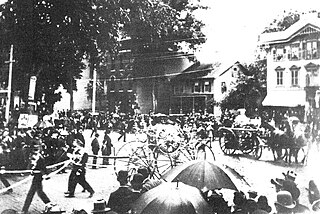
The Gong on the Hook and Ladder or Firemen's Parade on Main Street, normally shortened as The Gong on the Hook and Ladder and also initially entitled Allegro moderato, is a short composition by American composer Charles Ives.
Music for the Dance No. 2 is a composition for piano by American composer Leonard Bernstein. It was finished in 1938.
Non troppo presto, sometimes alternatively entitled Music for the Dance No. 1, refers to an untitled composition for piano by American composer Leonard Bernstein, written in 1937.
Touches: Chorale, Eight Variations and Coda, often shortened as Touches, is a composition by American composer Leonard Bernstein. Composed in 1980, it is one of Bernstein's last compositions for solo piano.
Four Sabras is a short composition for solo piano by American composer Leonard Bernstein. Each Sabra refers to vignettes or portraits of different fictitious Israeli children.
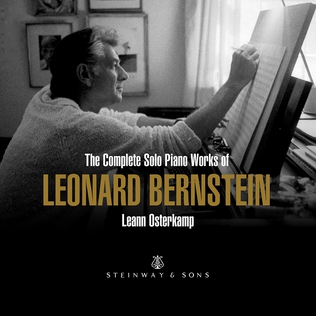
Bridal Suite is a suite for two pianists by American composer Leonard Bernstein. Composed in 1960, it was written for Phyllis Newman's wedding with Adolph Green.
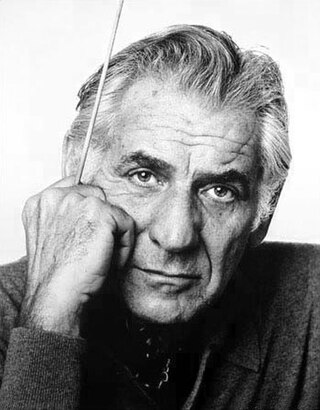
Divertimento, or Divertimento for Orchestra, is a suite of eight orchestral bagatelles by American composer Leonard Bernstein. Completed in 1980 and written to celebrate the centenary of the Boston Symphony Orchestra, it is well-known for featuring the notes B and C in most of its melodic material.

Opus Two is an American violin and piano chamber music ensemble featuring violinist William Terwilliger and pianist Andrew Cooperstock. They are known for their contributions to the violin-piano duo repertoire and their performances and recordings of original American music for violin and piano.
References
- ↑ Burton, Humphrey (1995). Leonard Bernstein. London: Faber and Faber. ISBN 978-0-571-17368-6.
- 1 2 "Works | Works | Leonard Bernstein". leonardbernstein.com. Retrieved 8 August 2021.
- 1 2 3 "BERNSTEIN, L.: Piano Music - Anniversaries / Piano Sonata / Music for the Dance No. 2 / Non Troppo Presto (Dossin)". www.naxos.com. Retrieved 8 August 2021.
- 1 2 3 Bernstein, Leonard (2010). Music for piano. [New York, NY]: Leonard Bernstein Music Publishing Company. ISBN 9781423475149.
- ↑ Bernstein, Leonard (1999). Leonard Bernstein: The Harvard Years 1935-1939. Eos Orchestra. ISBN 978-0-9648083-4-8 . Retrieved 9 August 2021.
- ↑ "BERNSTEIN, L.: Piano Music - Anniversaries / Piano Sonata / Music for the Dance No. 2 / Non Troppo Presto (Dossin) - 8.559756". www.naxos.com. Retrieved 5 August 2021.
- ↑ "Complete Solo Piano Works of Leonard Bernstein - Steinway & Sons". www.steinway.com. Retrieved 5 August 2021.
- ↑ "Leonard Bernstein: The Complete Music for Piano; Andrew Cooperstock, piano; BRIDGE 9485A/B". Bridge Records. Retrieved 5 August 2021.
- ↑ "CD bernstein piano works – Katie Mahan" (in German). Retrieved 8 August 2021.
- ↑ "BERNSTEIN Complete Works". www.deutschegrammophon.com. Retrieved 8 August 2021.
- ↑ "Bernstein: Complete Solo Piano Music - Brilliant Classics". www.piano-classics.com (in Dutch). Retrieved 5 August 2021.